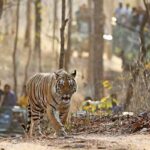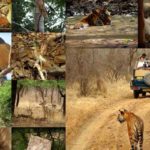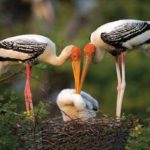Kanha National Park is one of India’s most visited wildlife destinations. With a core area of 940 square kilometres and a buffer zone of more than 1,000 square kilometres, it is no surprise that it is Central India’s largest park, with a vast forested cover of thick Sal and Bamboo groves, Grassy meadows and many ravines and rivulets support a diverse range of wildlife and biodiversity.
The Kanha National Park was originally part of the Gondwanas, or “Land of the Gonds,” and was administered by the Gond Dynasty until 1879, when the British declared it a reserved forest. It was converted to a wildlife sanctuary in 1933, and then to a national park in 1955. The park was upgraded once more in 1973, when it was designated as a tiger reserve as part of the central government’s “Project Tiger,” which was initiated the same year and aimed to conserve and increase the tiger population throughout India. Kanha is now one of India’s most famous tiger reserves, home to nearly 80 tigers and their 40 cubs.
Apart from that, there is one more feature that distinguishes Kanha: the Hard-Ground Barasingha, Madhya Pradesh’s state animal, is only found in this park. It’s worth noting that this deer population was on the brink of extinction just a few years ago; it’s only because of the park’s comprehensive conservation strategy and sound management methods that the meadows here are once again echoing with their rutting calls.
Those interested in visiting Kanha National Park can contact the park’s visitor centre. It’s important to note that the park is divided into four main zones: Kanha, Kisli, Mukki, and Sarhi. Wildlife safaris, birding tours, and jeep excursions are all available in each district. Having said that, since all of the zones are very far apart, arranging a stay near the zone for which the permit has been issued is always a good idea.
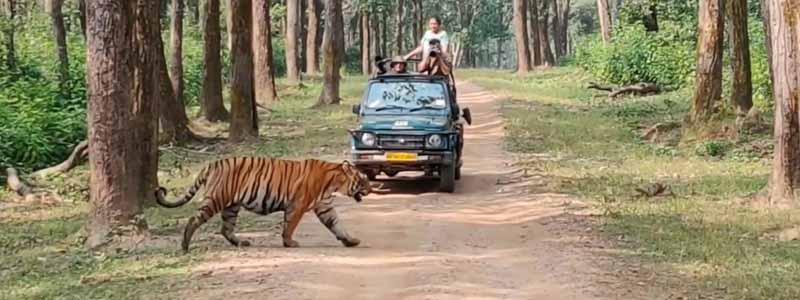
History
Kanha Tiger Reserve Originally a part of the Gondwanas (i.e. the land of the Gonds) in the year 1880, the Kanha Tiger Reserve (at an altitude range of 600m-870 m) was inhabited by two major tribes of Central India, the Gonds and the Baigas which is still being captured by these tribes at its outskirts and then later was entranced by two major sanctuaries, the Hallon and the Banjar sanctuaries by covering the areas of 250 sq km and 300 sq km respectively. In the year 1862, Kanha was inhibited by the forest management rules where many illegal acts we
re prohibited in the jungle. Further, in 1879, the area was declared as a reserve forest by extending its parts into 1949 sq km and with the introduction of “The Jungle Book”, the amazing landscape of Kanha and Pench came into recognition in 1880. The history of Kanha National Park became more interesting when in the year 1933, Kanha was declared as a sanctuary after receiving notable appreciation from worldwide due to its unmatchable landscape and amazing highland beauty. Gradually, many naturalists found Kanha as the premier national park in India and in 1991 and in 2001 Kanha National Park was honored as the most tourism friendly national park in India by the Dept. of Tourism, Govt. of India.
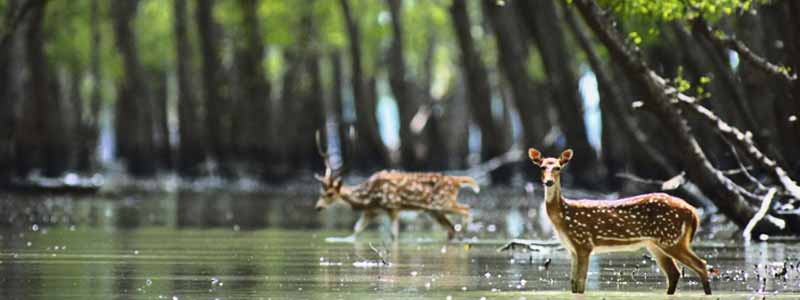
Major Wildlife Attractions Of Kanha
The main wildlife attractions in the park are tiger, bison, gaur, sambhar, chital, more pictures…. barasingha, barking deer, black deer, black buck, chousingha, nilgai, mouse deer, sloth bear, jackal fox, porcupine, hyena, jungle cat, python, pea fowl, hare, monkey, mongoose, tiger, and leopard.
The birds species in the park include storks, teals, pintails, pond herons, egrets, peacock, pea fowl, jungle fowl, spur fowl, partridges, quails, ring doves, spotted parakeets, green pigeons, rock pigeons, cuckoos, papihas, rollers, bee-eater, hoopoes, drongos, warblers, kingfishers, woodpeckers, finches, orioles, owls, and fly catchers.
However, if one animal species were to represent Kanha, it would probably be the barasingha, or the swamp deer. The barasinghas at Kanha are unique, being the hard ground variety, which populate the large open tracts of grass amidst the forests of teak and bamboo. Twenty years ago, the barasingha was faced with extinction but some desperate measures including the fencing-off of some animals helped save them and again the air in Kanha bugle with their rutting calls.
The open meadows during the cold winter months are usually teeming with barasinghas and there is plenty of tiger activity around the fringes. A female with two small cubs would circle around at least two or three times during the day and the swamp deer would go berserk, their husky alarm calls ringing through the jungle. Far from being the cunning, smart aleck, portrayed in Disney’s adaptation of the Jungle Book, the real “Sher Khan” is true blue-blooded royalty.
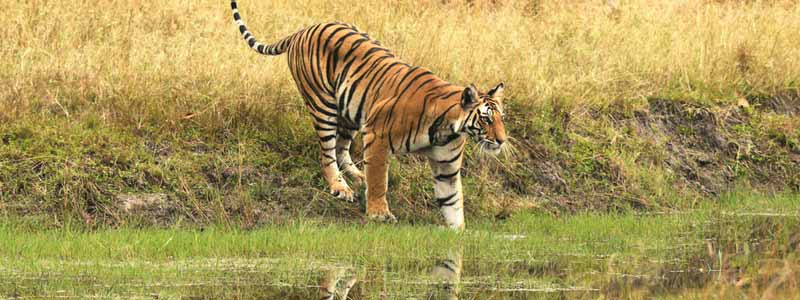
Kanha Museum
Visiting the Kanha Museum is an integral part of an excursion to Kanha National Park. It is a significant tourist attraction in the Kanha National Park. The museum is managed by the Forest Department. Here, you can get ample information about the park and its animals. It is a large museum exhibiting skeletons of various reptiles, carnivores, and other animals. You can also get some interesting insights into animals and their behaviour.
If you are interested in the history of this place, you can get it here quite comprehensively. There are specimens, charts, models and photographs that offer a detailed insight into the food pyramid prevalent in this forest. The sound show held in the museum in the evenings can be an enchanting experience too.
1. Mandla
Located at a distance of about 35 kilometres from the Kanha National Park, Mandla is known for its forts, temples and bounties of nature. It is one of the most popular tourist destinations near Kanha National Park. It is a town located on the banks of Narmada River.
However, it is more than just a town by the riverside; it is surrounded by the river on three sides. That imparts the town with ample natural beauty. The catchment area of the river and its tributaries abound in forest cover accentuate the beauty of the place. What makes it an enthralling destination though is not just the forest cover or the river; it is the ensemble of all these along with the historical forts and temples.
The famous fort in Mandla was built during the reign of the Gond Kingdom. The fort is surrounded by the Narmada River on three sides at a strategic location. You can feel the medieval vibe of the monument as you enter it.
There is also a hot water spring in Mandla, at a distance of about 20 kilometres from the town. The sulphur-rich and hot water of this spring is said to be beneficial for skin diseases. There is also a beautiful lake nearby.
At a distance of about 5 kilometres from Mandla town lies Sahastradhara. The significance of this place lies in the fact that here the Narmada splits into several grey and white streams and flows through the limestone and basalt rocks creating a symphony of colours. It is an incredible experience to watch these coloured streams drifting and bouncing along. There is also an old temple here dedicated to Lord Shiva.
2. Kawardha Palace
At Raipur in Chattisgarh, at a distance of about 91 kilometres from the Kanha National Park, you can find the majestic Kawardha Palace. This sprawling monument of absolute luxury is spread over an area of 11 acres surrounded by a green canopy. The palace is built with imported Italian marble and stone. The splendid façade of this imposing and sprawling two-storied palace is visible from a distance. However, it is not just the palace, but also the ambience around the palace that makes this place such an enchanting destination. You can get a panoramic view of the Maikal Hill Range from here.
What is truly exciting is that you can stay in this beautiful palace as it has been converted into a heritage hotel. So, if the expenses are not much of a concern, make sure to spend at least a night here. You can soak in a lifetime of experience of the royal life. You can enjoy all the luxuries that you would expect of a modern hotel. The royal patronage accentuates that experience. There is also an evening bar here which doubles up as a library.
Amarkantak
At a distance of about 159 kilometres from Kanha National Park lies Amarkantak, one of the most significant places to visit in Madhya Pradesh. It is a place with abundant natural heritage where you can find a variety of plants with medicinal properties and experience many more exciting activities.
It is famous as the origin of three rivers – Narmada, Johila and Sone. The Dudh Dhara Waterfalls is another charming attraction of Amarkantak. The waterfall gets its name from the foaming water that resembles milk. There is an ancient Lord Shiva temple here the locals refer to as Pataleshwar Mahadev Temple, which is believed to be established during the reign of the Kalchuri Dynasty. The Narmada Udgam Temple celebrates the origin of the river Narmada. The temples display attractive architectural nuances.
4. Jabalpur
Approximately 164 kilometres from Kanha National Park, you will find Jabalpur, often referred to as the soul of Madhya Pradesh and one of the most popular places to visit in Madhya Pradesh.
It is a city that boasts of marble mountains. On a moonlit night, the changing colours of the imposing marble mountains and the crisscrossing Narmada River can cast a magical spell on visitors. It is indeed an exciting and enriching experience.
However, it is not just the marble mountains that make Jabalpur an exciting destination to visit. The Madan Mahal Fort, Dhuandhar Waterfalls, Dumna, Bhedaghat etc. are some of the other enchanting places that tourists love visiting when in the city.
Amarnath also has an abundance of spiritual attractions. This includes the thousand-year-old Chausath Yogini Temple, the Gwarighat Gurudwara on the bank of the river, the Kanchnar Temple housing a 76-feet tall statue of Lord Shiva and more.
Dhuandhar Falls is one of the most popular places in Jabalpur. This cascading and misty waterfall offers a bewitching sight to behold. The site also boasts of some historic forts and museums like the Madan Mahal Fort, Rani Durgawati Museum etc. It is the ensemble of all these sights and experiences that make Jabalpur, the third largest city in Madhya Pradesh, an enchanting place to visit.
The Best time to visit Kanha National Park
Now to the bit that you expect from an expert travel guide! The best time to visit Kanha National park is between October and March. Although the park is opened mostly from 15th October till the end of June, the weather from October to March is quite pleasant. That means you’ll enjoy your safari in Kanha National Park even more during this time.
How to Reach:
By Air : The Nearest Airport for Kanha National Park are Jabalpur 160 Kms, Raipur Airport 250 Kms & Nagpur Airport 300 Kms.
By Train : The Nearest Railway Stations for accessing Kanha National Park is Gondia & Jabalpur. Gondia railway station is 145kms / 03:00 hrs drive from Kanha (Khatia Entrance Gate). Jabalpur railway station is 160kms / 04:00 hrs drive from Kanha (Mukki Entrance Gate)
By Road : By Road Kanha National Park is well connected from the major destinations of Madhya Pradesh, Maharashtra & Chhattisgarh.

